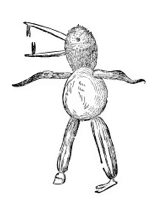A lawn is lit by souls asleep
in tandem or alone, or hiding in a hive
averse to soil, a crypt. Above
stands a crane who does not dance
around. His graceful leg is a sundial.
But what's the stone a crane holds while he bends
one leg? They say a stone keeps the crane
bent from ever dozing off. If it drops, it hits the bottom
of his other leg. But the crane really carries a
bee, which never stings the silent
crane, because it doesn't judge him for holding it close
so long. The crane, unlike us,
cannot dream of bees and, therefore, does not die—he caresses
the bee, whose spirit would rather wander, like ours, out of the still
cradle of the crane's
dark palm. These small actions of thought are daily
in the cemetery when one is not noticing
doves, who sing the song of a stone doorway.
A whole genre of song, once in books, for the good
death, which used to happen at home.
Everyone then knew how to die, even
if illiterate, and family
excursions to the cemetery were popular, like emblazoned
symbols. The parents woke their children
early to walk to the gates where the regardful
faces of Janus either let you in or forgot
to keep you out. His
four eyes weighed the soul like a scale and human hands held felt
flowers that could bob and dance,
float among the visitors like a parade of lanterns
greeting the stones that represent the greatness
of matter. The hardened
ground hardened itself, so graves
could not be dug very deep. Pebbles
go on top. The rock mounds
happened as grave markers by accident, should you happen
to believe in accidents. If a nomad
had to pass the gravesite of another tribe, he
might repair a plot by adding stones.
How did he know whose
it was wasn't a question he asked. If
it's too arid to cry, you can leave objects
instead— flowers (real), immorteles
(ceramic), toys, ten cents, and fallen
insects (especially the canty and
joyful water witch, a national emblem of the Japanese
island of Honshu, which some believe can
join the eyelids for the journey
ahead). But I shouldn't
just tell you of good things that help us sleep when the things
keeping us awake are as ageless. The King
of Terrors chimes the rusted
keys of Time and swings them as a scythe to harvest the souls of knights
and pharaohs alike, waiting outside a church,
kiosk of Trajan, east of the Nile in Egypt
leaning against lily-topped
columns that echo unfolding
life while two cobras answer with death, above papyrus leaves
for knowledge and rebirth. A
little more confusing when vulture wings symbolize
maternal care. Not as baffling as the pelican though, who might
be feeding her babies from a pouch
many believe to be her flesh, a common mistake,
as though babies eat blood for anyone but the dreaming
martyr. Craftsmen built the birds of prey and it's impossible
not to suffer as a symbol. Next
is the woodpecker, an able storm-predictor, who would
not help God make trenches for rivers and lakes. Now
he is a headbanger, though Romulus and Remus
needed his food delivery services
often when making Rome. There's the owl
who hates light and never cries when crying
offers the only neutralizer of poison. Once
upon a time before our eyes were rocks, before the columns broke
off and fell into the center of the earth, the whole family
produced tears together, not as a trick or decorative device but to pacify
the soul leaving the house, to tell them that water yields
plants and the daffodil finds light in paradise
as often as in the underworld, where no pagan soul's
poor, wrapped in clovers. One
question the youngest has quite
often: are they coming back?
Queen of Heaven never returns them. There are more questions
about her crown, its magical
qualities, and whether she
really kisses each soul goodnight. Nothing at night is reliable.
The spotted sky is an aviary for our imaginations of
real ones. The pathway to the sun is filled with burning eagles, redeemed
by plunging back into the waters of the tiny
red earth. The sacred eagle, it is
said, no matter his hunger, was so
generous he left half his prey for other creatures and
sometimes had twin heads. Though perhaps somewhere
each unacquainted
single-headed eagle was leaving
the other half for his discarded twin.
As the eagles fell back to earth, like
torches inverted, they threw themselves
into the Nile with the desire of a lover
that listens to the blossom of a pansy to
understand the lost thoughts of her beloved. The smell under
flowers: drowsiness. Some symbols remain
unasked about, like seedpods and buds, which when broken usually
represent infants. How
unfortunate to see the lamb look upon the day's eye covering
vaults, sealed from experience, so the daisy never varies
from being a ceaseless
vigil for innocence, not a variation
of loves me / loves me not, which is
very foreign to a baby, who should never
wonder about these things. We
start again
with the crane, which
led to families and
what they do with tears. None of this is exact.
Yew trees give a maze of shade when you sleep
beneath the creeping boughs
yellow with buzzing, mutant yawns
from a tower of the winds, which toward
youth calls.



